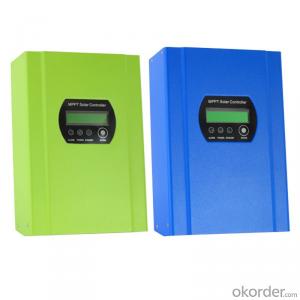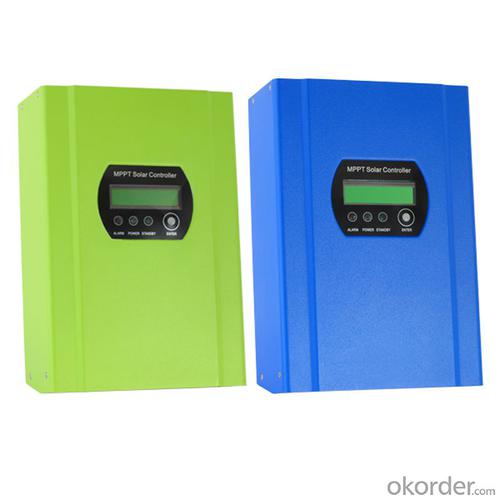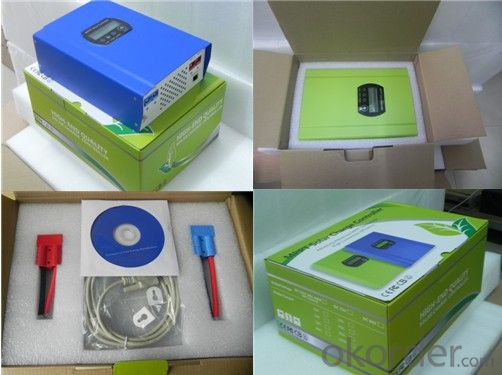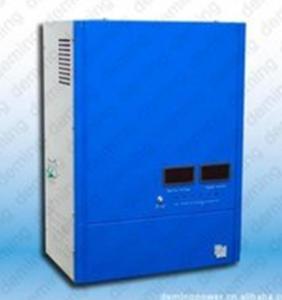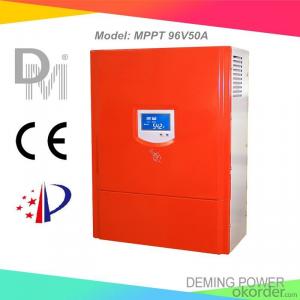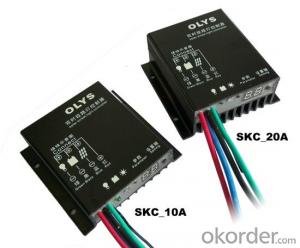German Solar Controllers Multifunctional 30A 96V Battery MPPT Solar Charge Controller 20A~30A
- Loading Port:
- China main port
- Payment Terms:
- TT OR LC
- Min Order Qty:
- 20 unit
- Supply Capability:
- 9999 unit/month
OKorder Service Pledge
OKorder Financial Service
You Might Also Like
96V Auto identification MPPT Solar Charge Regulator 30A with LCD and LED
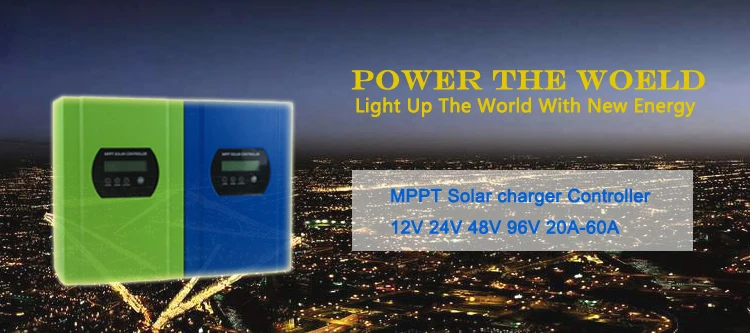
| Introduction |
This is a smart solar charge controller which has advanced MPPT technology .
Solar charge controller is one of the important parts in the off-grid solar system.
For having the advanced MPPT technology, the controller can trace the peak power with 99%
conversion efficiency. MPPT microprocessor, inside the controller,making 30% more charge
current with significantly less power than tradition. In addition to this, easier installing and supporting
to expand volume are other advantages. It can also store energy to different kinds of batteries.
We provide battery choice(Vented,Sealed,Gel,NiCd).
| Product Show |
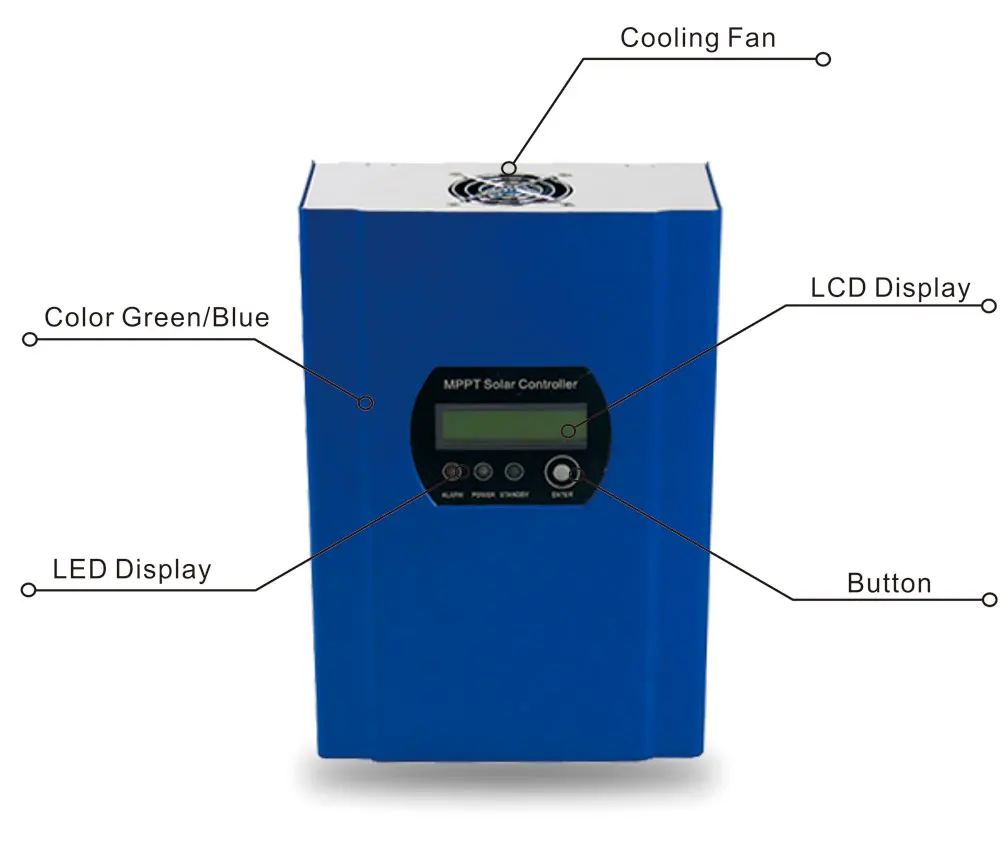
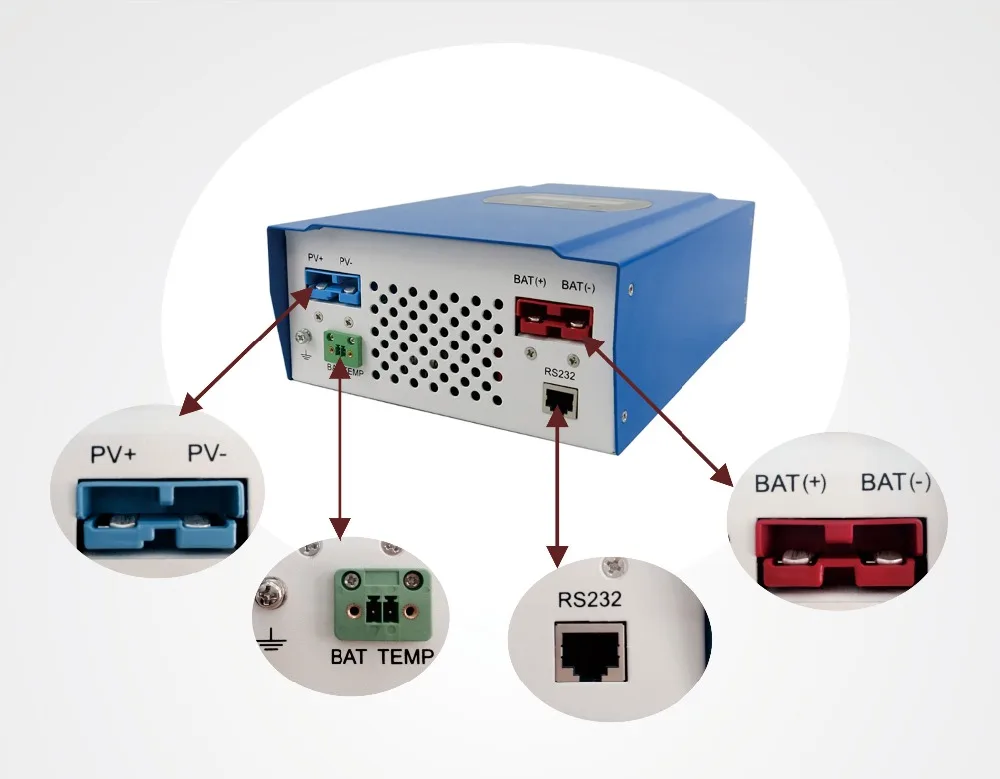
Please check the design brief,technical documents,product manual etc .
| Features |
1. Peak efficiency upto 99% with MPPT,increasing 30%~60% efficiency than traditional controller.
2. 12v/24v/48v system voltage automatic recognize.
3. Maximum input PV voltage upto DC150V.
4. 105degrees can be sufferred by good components.
5. Charge mode: three stages (fast charge, constant charge, floating charge)
6. Support kinds of batteries:Gel,Sealed lead acid,vented,NiCd,etc.
7. LCD and LEDs show parameters and system information,like PV input voltage,battery voltage,charge current,charge power,etc.
8. Port RS232 or connects to PC with upper software to show working state and parameters in 11 languages.
9. CE,RoHS certificatons approved.
10. 2 years warranty;3~10 years extended technical service.
| Application |
Off grid PV system show with our I-P-TPI Pure sine wave inverter:
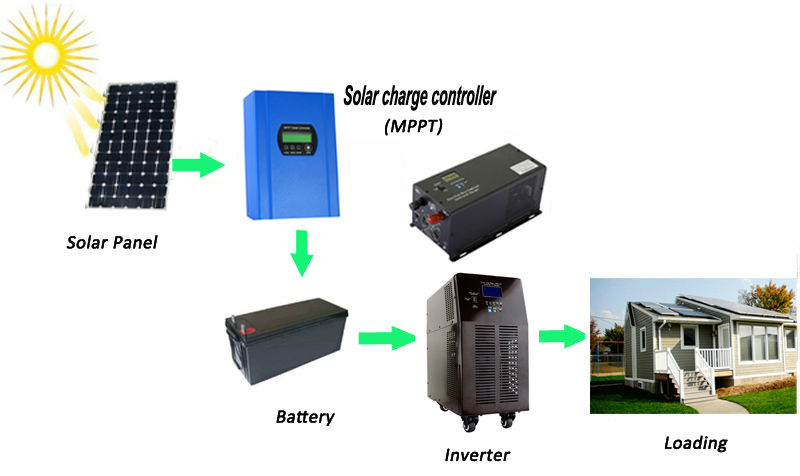
| Parameter |
Model: I-P-MSC-DC12V/24V/48V/96V-series | 20A | 30A | ||
Charge Mode | Maximum Power Point Tracking | |||
Method | 3 stages: fast charge(MPPT),constant voltage,floating charge | |||
System Type | DC12V/24V/48V/96V | Automatic recognition | ||
System Voltage | 12V system | DC9V~DC15V | ||
24V system | DC18V~DC30V | |||
48Vsystem | DC36V~DC60V | |||
96Vsystem | DC72V~DC120V | |||
Soft Start Time | 12V/24V/48V/96V | ≤10S | ||
Dynamic Response Recovery Time | 12V/24V/48V/96V | 500us | ||
Conversion Efficiency | 12V/24V/48V/96V | ≥96.5%,≤99% | ||
PV Modules Utilization Rate | 12V/24V/48V/96V | ≥99% | ||
Input Characteristics | ||||
MPPT Working Voltage and Range | 12V system | DC18V~DC150V | ||
24V system | DC34~DC150V | |||
48V system | DC65~DC150V | |||
96Vsystem | DC125~DC300V | |||
Low Voltage Input Protection Point | 12V system | DC16V | ||
24V system | DC30V | |||
48V system | DC60V | |||
96Vsystem | DC120V | |||
Low Voltage Input Recovery Point | 12V system | DC22V | ||
24V system | DC34V | |||
48V system | DC65V | |||
96Vsystem | DC125V | |||
Max DC Voltage | 12V/24V/48V system | DC160V | ||
96Vsystem | DC300V | |||
Input Overvoltage Protection Point | 12V/24V/48V system | DC150 | ||
96Vsystem | DC300V | |||
Input Overvoltage Recovery Point | 12V/24V/48V system | DC145V | ||
96Vsystem | DC295V | |||
Max. PV Power | 12V system | 280W | 450W | |
24V system | 560W | 850W | ||
48V system | 1120W | 1700W | ||
96Vsystem | 2240W | 3400W | ||
Output Characteristics | ||||
Selectable Battery Types (Default type is GEL battery) | 12V/24V/48V/96Vsystem | Sealed lead acid, vented, Gel, NiCd battery | ||
Constant Voltage | 12V/24V/48V/96Vsystem | Please check the charge voltage according to the battery type form. | ||
Floating Charge Voltage | 12V/24V/48V/96Vsystem | |||
Over Charge Protection Voltage | 12V system | 14.6V | ||
24V system | 29.2V | |||
48V system | 58.4V | |||
96V system | 116.8V | |||
Rated Output Current | 12V/24V/48V/96Vsystem | 20A | 30A | |
Current-limiting Protection | 12V/24V/48V/96Vsystem | 25A | 35A | |
Temperature Factor | 12V/24V/48V/96Vsystem | ±0.02%/℃ | ||
Temperature Compensation | 12V/24V/48V/96Vsystem | 14.2V-(The highest temperature-25℃)*0.3 | ||
Output Ripples(peak) | 12V/24V/48V/96Vsystem | 200mV | ||
Output Voltage Stability Precision | 12V/24V/48V/96Vsystem | ≤±1.5% | ||
The specification is only for reference. Subject to change without prior notice.
RS232 Function working stat |
The Figures of the PC Firmware and Testing Software:
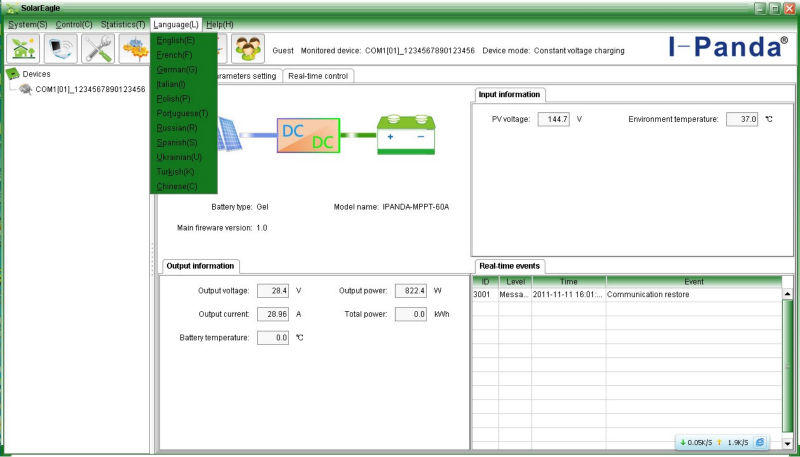
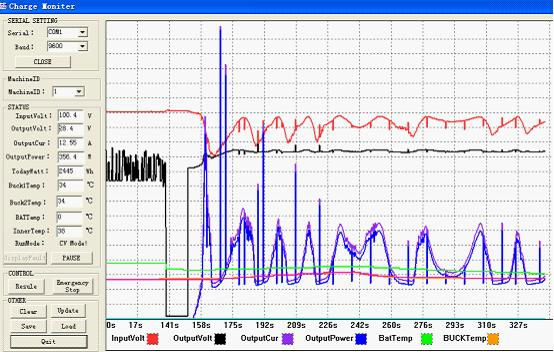
We provide OEM and ODM service.The 36V/72V/96V model also can be custom made for you.
Packaging |
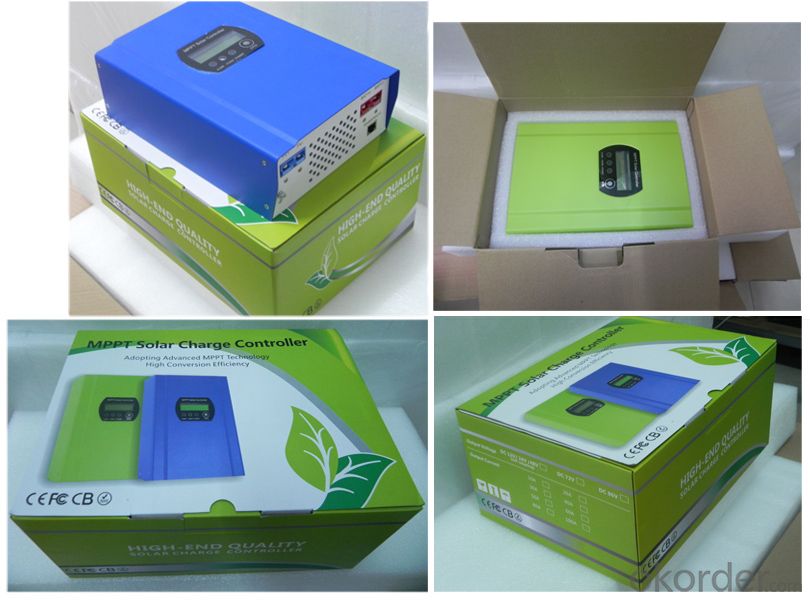
Certifications |
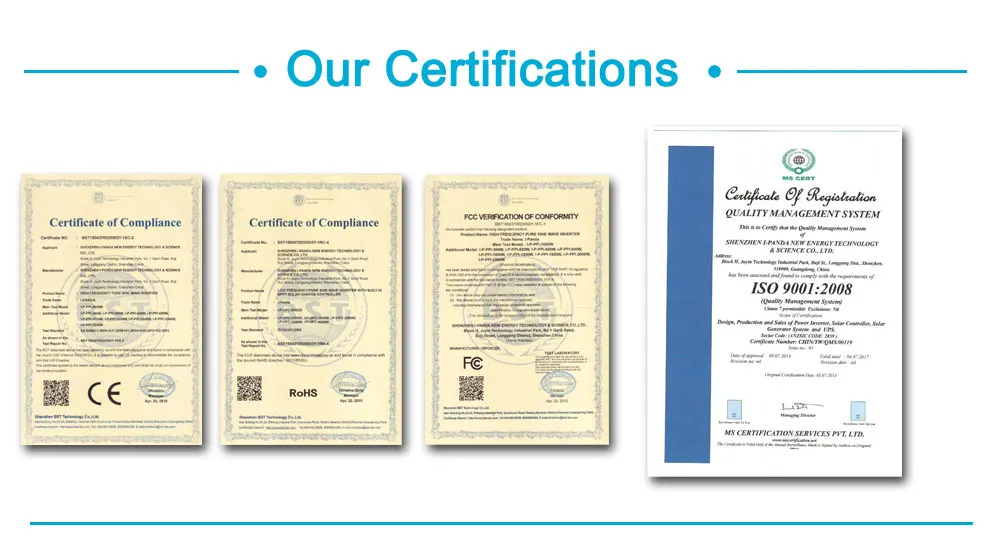
F&Q: |
Q1. How to ensure and monitor the products quality?
A1: We have established a perfect Quality Management System, In strict
accordance with ISO9001: 2008 quality system and ISO14001 environment system for quality assurance management;
Our ISO9001:2008 Quality System certificate encoding: CHIN/TW/QMS/00119;
Our ISO14001 Environment System certificate encoding: CHIN/TW/EMS/00028;
Q2. What is the warranty of products?
A2: The warranty period of different products are different; 5 years, 3 years, 2 years, 1 years; More details please refer to the product specification or manual; we will provide free life-long technical support ;
Q3. What is the difference between MPPT&PWM?
A3. MPPT charging mode, peak efficiency up to 99%, saving 30%~60% solar panel than traditional PWM controller.
- Q: How does a solar controller prevent reverse current flow from the battery to the solar panels?
- A solar controller prevents reverse current flow from the battery to the solar panels by incorporating a blocking diode in its circuitry. This diode acts as a one-way valve, allowing current to flow from the solar panels to the battery but blocking any reverse flow. As a result, the battery remains protected and the solar panels are not damaged by the battery's discharge.
- Q: What is the difference between a PWM and MPPT solar controller?
- A PWM (Pulse Width Modulation) solar controller regulates the voltage output of a solar panel by rapidly switching the panel's output on and off. This results in a fixed voltage output, which may not be optimal for charging batteries or maximizing power output. On the other hand, an MPPT (Maximum Power Point Tracking) solar controller continuously adjusts the voltage and current to find the optimal operating point, known as the maximum power point (MPP), of the solar panel. This allows for higher power conversion efficiency, especially in conditions where the solar panel's output voltage is different from the battery's voltage. In summary, while a PWM controller regulates voltage through on-off switching, an MPPT controller dynamically adjusts voltage and current to maximize power output from the solar panel.
- Q: Can a solar controller be used with a solar-powered fish farm?
- Yes, a solar controller can be used with a solar-powered fish farm. A solar controller regulates the charging and discharging of batteries in a solar power system, ensuring optimal performance and protection. In a solar-powered fish farm, the solar controller can be used to manage the solar panels' energy output, ensuring a constant and efficient power supply to the farm's infrastructure, such as pumps, aerators, and monitoring systems.
- Q: Can a solar controller be used in harsh weather conditions?
- Yes, a solar controller can be used in harsh weather conditions. Most solar controllers are designed to be weather-resistant and can withstand various environmental conditions such as extreme temperatures, rain, snow, and high winds. However, it is always recommended to check the specifications and guidelines provided by the manufacturer to ensure the controller is suitable for the specific harsh weather conditions it will be exposed to.
- Q: Can a solar controller be used with solar panel arrays in series?
- Yes, a solar controller can be used with solar panel arrays in series. The solar controller regulates and optimizes the charging of the batteries, regardless of the configuration of the solar panels.
- Q: Can a solar controller be used with a 12V battery system?
- Yes, a solar controller can be used with a 12V battery system. The solar controller regulates the flow of energy from the solar panels to the battery, ensuring that the battery is not overcharged. It is compatible with 12V battery systems and helps optimize the charging process for maximum efficiency and battery life.
- Q: What is the role of a solar controller in maintaining battery health?
- The role of a solar controller in maintaining battery health is crucial. A solar controller acts as a regulator and protector for the battery connected to a solar power system. It ensures that the battery is charged and discharged properly, preventing overcharging and deep discharging, which can significantly impact the lifespan and overall health of the battery. One of the main functions of a solar controller is to monitor and control the charging process of the battery. It regulates the flow of current from the solar panels to the battery, ensuring that the battery receives the appropriate charge based on its capacity and state of charge. By controlling the charging process, the solar controller prevents overcharging, which can cause damage to the battery, such as reduced capacity or even permanent failure. Additionally, a solar controller plays a vital role in preventing deep discharging of the battery. When a battery is discharged beyond a certain point, it can lead to irreversible damage and reduced lifespan. The solar controller monitors the battery voltage and disconnects the load from the battery when it reaches a predetermined low voltage level. This helps to prevent deep discharging and ensures that the battery remains within safe operating limits. Furthermore, a solar controller often includes various protection mechanisms to safeguard the battery against potential issues. It may have features such as short-circuit protection, reverse polarity protection, and temperature compensation. These protections help to prevent any accidental damage to the battery caused by external factors or improper installation. In summary, the role of a solar controller in maintaining battery health is to regulate and protect the battery during the charging and discharging process. By preventing overcharging, deep discharging, and providing additional protection mechanisms, the solar controller helps to prolong the lifespan, optimize performance, and ensure the overall health of the battery in a solar power system.
- Q: Can a solar controller be used with solar string inverters?
- No, a solar controller cannot be used with solar string inverters. Solar controllers are typically used to regulate and control the charging of batteries in off-grid solar systems, while solar string inverters are used to convert the DC power generated by solar panels into AC power for use in grid-tied solar systems. These two components serve different purposes and are not compatible with each other.
- Q: Can a solar controller be used with a grid-tied solar system?
- No, a solar controller is not typically used with a grid-tied solar system. Grid-tied systems are designed to directly connect to the electrical grid, allowing excess energy to be fed back into the grid. Solar controllers, on the other hand, are commonly used in off-grid systems to regulate and optimize the charging of batteries.
- Q: Can a solar controller be used in a solar-powered electric bike charging system?
- Yes, a solar controller can be used in a solar-powered electric bike charging system. A solar controller helps regulate the voltage and current from the solar panels to ensure efficient charging and protection of the batteries in the electric bike.
Send your message to us
German Solar Controllers Multifunctional 30A 96V Battery MPPT Solar Charge Controller 20A~30A
- Loading Port:
- China main port
- Payment Terms:
- TT OR LC
- Min Order Qty:
- 20 unit
- Supply Capability:
- 9999 unit/month
OKorder Service Pledge
OKorder Financial Service
Similar products
Hot products
Hot Searches
Related keywords
